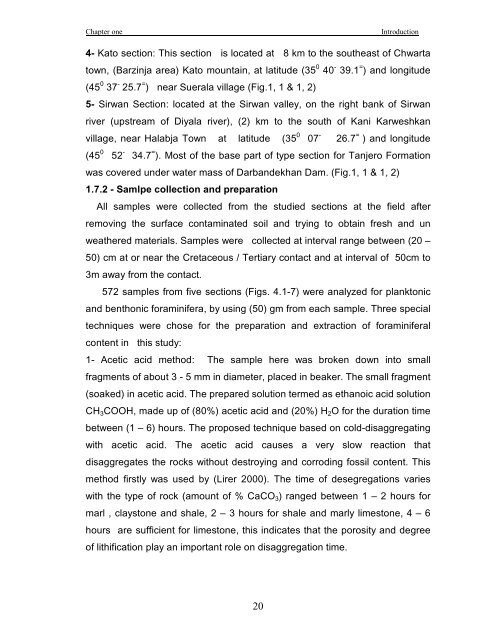biostratigraphy and paleoecology of cretaceous/tertiary boundary in ...
biostratigraphy and paleoecology of cretaceous/tertiary boundary in ...
biostratigraphy and paleoecology of cretaceous/tertiary boundary in ...
Create successful ePaper yourself
Turn your PDF publications into a flip-book with our unique Google optimized e-Paper software.
Chapter one<br />
Introduction<br />
4- Kato section: This section is located at 8 km to the southeast <strong>of</strong> Chwarta<br />
town, (Barz<strong>in</strong>ja area) Kato mounta<strong>in</strong>, at latitude (35 0 40 - 39.1 = ) <strong>and</strong> longitude<br />
(45 0 37 - 25.7 = ) near Suerala village (Fig.1, 1 & 1, 2)<br />
5- Sirwan Section: located at the Sirwan valley, on the right bank <strong>of</strong> Sirwan<br />
river (upstream <strong>of</strong> Diyala river), (2) km to the south <strong>of</strong> Kani Karweshkan<br />
village, near Halabja Town at latitude (35 0 07 - 26.7 = ) <strong>and</strong> longitude<br />
(45 0 52 - 34.7 = ). Most <strong>of</strong> the base part <strong>of</strong> type section for Tanjero Formation<br />
was covered under water mass <strong>of</strong> Darb<strong>and</strong>ekhan Dam. (Fig.1, 1 & 1, 2)<br />
1.7.2 - Samlpe collection <strong>and</strong> preparation<br />
All samples were collected from the studied sections at the field after<br />
remov<strong>in</strong>g the surface contam<strong>in</strong>ated soil <strong>and</strong> try<strong>in</strong>g to obta<strong>in</strong> fresh <strong>and</strong> un<br />
weathered materials. Samples were collected at <strong>in</strong>terval range between (20 –<br />
50) cm at or near the Cretaceous / Tertiary contact <strong>and</strong> at <strong>in</strong>terval <strong>of</strong> 50cm to<br />
3m away from the contact.<br />
572 samples from five sections (Figs. 4.1-7) were analyzed for planktonic<br />
<strong>and</strong> benthonic foram<strong>in</strong>ifera, by us<strong>in</strong>g (50) gm from each sample. Three special<br />
techniques were chose for the preparation <strong>and</strong> extraction <strong>of</strong> foram<strong>in</strong>iferal<br />
content <strong>in</strong> this study:<br />
1- Acetic acid method: The sample here was broken down <strong>in</strong>to small<br />
fragments <strong>of</strong> about 3 - 5 mm <strong>in</strong> diameter, placed <strong>in</strong> beaker. The small fragment<br />
(soaked) <strong>in</strong> acetic acid. The prepared solution termed as ethanoic acid solution<br />
CH 3 COOH, made up <strong>of</strong> (80%) acetic acid <strong>and</strong> (20%) H 2 O for the duration time<br />
between (1 – 6) hours. The proposed technique based on cold-disaggregat<strong>in</strong>g<br />
with acetic acid. The acetic acid causes a very slow reaction that<br />
disaggregates the rocks without destroy<strong>in</strong>g <strong>and</strong> corrod<strong>in</strong>g fossil content. This<br />
method firstly was used by (Lirer 2000). The time <strong>of</strong> desegregations varies<br />
with the type <strong>of</strong> rock (amount <strong>of</strong> % CaCO 3 ) ranged between 1 – 2 hours for<br />
marl , claystone <strong>and</strong> shale, 2 – 3 hours for shale <strong>and</strong> marly limestone, 4 – 6<br />
hours are sufficient for limestone, this <strong>in</strong>dicates that the porosity <strong>and</strong> degree<br />
<strong>of</strong> lithification play an important role on disaggregation time.<br />
20

















